Germplasm Conservation of Camellias in China
Jiyuan Li (1) and Sui Ni (2), China
(1) Research Institute of Subtropical Forestry,
No.73 Daqiao Road,
Fuyang City,
Zhejiang Province,
P.R.China, 311400
(2) Faculty of Life Science and Biotechnology,
Ningbo University,
No.818 Fenghua Road,
Ningbo City,
Zhejiang Province,
P.R.China, 315211
First published in the International Camellia Society Journal 2011
China is a rich resource of camellia species, accounting for 90% of the total number of species of the genus Camellia in the world. Furthermore, Camellia is one of the top-ten traditional ornamental flowers and has been cultivated for more than two thousand years in China. According to research in historical literature, it is evident that Camellia was first introduced to Japan around the 7th century, and introduced into England in 1739, then gradually spread to the Western countries. With the frequent international exchanges in the last half century, people are getting a deeper understanding of the cultivation of camellias, and the development of camellias is being encouraged. However, according to investigation on wild camellias, most of the wild camellia species resources are being endangered, although China is still rich in many camellia species resources. The major factors include building new roads, regeneration by other cash tree species, using wood as fuel in mountainous areas and transplanting ornamental plants in urban areas. During the last decades, governments at various levels have been paying more attention to camellia genetic germplasm conservation. Some relevant laws and regulations, such as laws of Forestry, Regulation of Natural Reserves, Regulation of Protection for Wild Plants, are already developed.
The camellia germplasm resources are mainly divided into two types of conservation in situ and ex-situ respectively. The current conservation status of camellias in China is briefly introduced as follows.
1. Conservation in situ
1.1 Nature Reserves
1.1.1 National Nature Reserve of Yellow Camellias in Fangchenggang City of Guangxi Autonomous Region
Yellow camellias were listed as First-Grade Protected plants by the State Forestry Administration. It is the only section of the Camellia genus with yellow flowers, known as the ‘Queen of Camellia’ and also as the ‘Panda of Flora’ in China. The Yellow Camellia Reserve with an area of about 9,195 hectares, separately established as the Provincial Level Nature Reserve in 1986 and as the State Level Nature Reserve in 1994, was located in Fangchenggang City of Guangxi Autonomous Region. According to the investigation, 95% of all wild yellow camellias are naturally distributed in the area of Fangchenggang and range of Mt. Shiwandashan. There are three species of C.nitidissima C.euphlebia and C.tunghinensis, and two varieties of C.chrysantha (Hu) Tuyama var. phaeopubisperma S.Y.Liang et Z.H.Tang, and C.nitidissima Chi var. longistyla (No et Zhang) S.Y.Liang. There are about 407,700 individual camellia plants in this reserve, of which 27,300 wild C. tunghinensis plants were found to be exclusively distributed here. In order to further protect the yellow camellia germplasm resources, a germplasm pool with an area of about 8,000 square meters was established in 2000, and another 23 yellow camellia species and 5 varieties were also introduced here.
1.1.2 E’huangzhang Nature Reserve in Yangchun City of Guangdong Province
This reserve is located in the intersection of the tropical and southern subtropical areas, which is extremely rich in new plant species resources. The famous C. changii Ye (C. azalea) was found here. C. changii Ye is known for the characteristics of ever-blooming. It is tolerant of high temperatures in summer (up to 35ºC) and low temperatures (down to -5ºC) in winter. It is the rare and precious germplasm which blooms in summer. At present, there are about 1700 individual plants found in the reserve. This species is only distributed on the sunny sides (about 8-10m away from the water level) of the downstream area of Honghuadan Hydropower Station in the Nature Reserve. The altitude of the whole distribution area is between 50 and 175m above sea level, with a total length of about 4km of the creek, and the distribution area is less than 100km2.
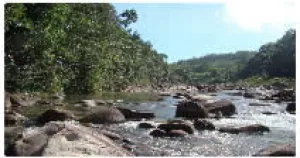 1.1.3 The Provincial Reserve of Zhujiajian Island of Zhoushan Islands group in Zhejiang Province
1.1.3 The Provincial Reserve of Zhujiajian Island of Zhoushan Islands group in Zhejiang Province
This reserve is located in the southeast part of the Zhoushan Islands. Its total area is about 60.88 square kilometers. The wild C. japonica is mainly distributed in Daqing Hill with the highest altitude up to 378.6 meters. Due to the strong sea wind all year round and rocky soil, the wild C.japonica plants are grown as bushes with a height of 1.5 to 2.5 meters, and base diameter of 5-10cm. According to investigations, some of the wild camellias are distinct in the shape of their leaves and flower petals, and some even bear semi-double flowers. These types of natural variation are rare in terms of genetic germplasm for breeding new ornamental camellias.
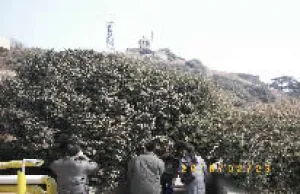 1.1.4 The Provincial Nature Reserve of Naidong Camellia on Changmengyan Island in Qingdao, Shandong Province
1.1.4 The Provincial Nature Reserve of Naidong Camellia on Changmengyan Island in Qingdao, Shandong Province
The famous Changmengyan Island is located in Qingdao of Shandong Province, with an area of only 0.16 square kilometers.
The lowest temperature recorded is minus 17ºC, and it frequently has snow in winter, and periods of heavy foggy weather lasting up to 50 days. However, the local Naidong Camellia (local name, meaning very tolerant of low temperatures in winter) is naturally distributed in this northernmost range. The age of these camellia plants ranges from 200 to 830 years old, and the number of plants is up to 495. The Naidong Camellia is evergreen, and flowers in winter and spring. This island possesses the most abundant resources of wild C. japonica. The Naidong Camellia was chosen as the city flower of Qingdao City in 1988.
(See You Muxian’s report in the 2009 International Journal. Editor.)
1.2 Wild ancient camellia trees
According to recent investigation, the wild ancient camellia trees were mainly found in Tengchong County of Yunnan Province, Jinshanjiang River Valley, Emeishan Mountain of Sichuan Province, Qionglaishan Mountain, Zhoushan Islands of Zhejiang Province, Laoshang Peninsula of Shandong Province, and Lichuan of Jiang Xi Province. The top-three numbers of wild ancient camellias are in Yunnan, Sichuan and Zhejiang Province. The city with the largest number of wild old C.reticulata trees is Chuxiong in Yunnan. In the eastern coastal region the area with the largest number of ancient C. japonica trees is Zhoushan Islands in Zhejiang Province.
1.2.1 Wild old Camellia reticulata trees
According to investigation in the last two decades, there are 171 ancient cultivated camellia trees found in Yunnan Province, of which 164 plants are from C.reticulata and the other 7 trees from C.japonica.
Chuxiong city is a most important gene pool of C.reticulata species, and is one of the main habitats of Yunnan camellias. The wild Yunnan camellias are mostly grown on Zixishan and Mt. Black Bull, where thousands of wild Yunnan camellia trees may be found. According to statistics, there is a total of 136 trees aged more than 100 years on Mt. Zixishan. The largest tree found on M. Black Bull is 14 meters tall, and 1.1 m wide at breast height. A wild camellia called ‘Baby Face’ is estimated to be more than 650 years old on Mt. Zixi. With such rich resources of wild old Yunnan camellias, Chuxiong is thus chosen as the host city of the 2012 International Camellia Congress.
Tengchong County was known as the hometown of Yunnan camellia (C.reticulata), and there is a saying that ‘The best Camellia is in Yunnan, and the best Yunnan camellia is in Tengchong’. This County has a favorable natural environment, and contains a large area of wild single-form camellias. Since it was used for oil extraction in the past, it is also named as Red Flower edible oil Camellia. The most abundant area of wild Red flower Camellia is in the town of Mazhan. It is a natural hybrid species, and has been growing over 600 years in Tengchong. There are nearly 1350 hectares of the original camellia stands on Yunhuashan, which is 18 kilometers away from Tengchong City and more ancient camellia trees over 500 year old are found there. Red Flower Camellias are usually distributed in the altitude range from 199 to 2200 meters. Some big ancient camellia trees may be found in each camellia oil production stand, up to 76 cm in diameter. Within the city, there are some ancient camellia trees aged 210 to 300 years old, whilst some 300 year old trees are found in the town of Shunxian, and 240 year old trees in Dongguan village. A semi-double flowered tree of Yunnan camellia, which is 7 meters tall, 70.63 cm in diameter, and aged 500 years, was found in Baotai Hill in Yongping county of Yunnan. The tallest ancient camellia tree in the world was found at Mt. Weibaoshan in Weishan County.
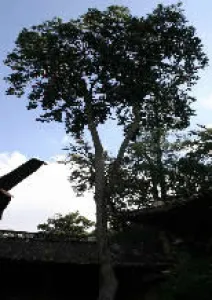 1.2.2 Wild ancient camellias in Sichuan Province
1.2.2 Wild ancient camellias in Sichuan Province
Thousands of wild ancient camellia trees are naturally grown on Emeishan, Qionglaishan and Longmenshan in Sichuan Province, central-western China. There are more than 9,000 wild trees aged over 100 years old even in the area of Kongba village in Hongya county. On Qionglaishan there are more than ten thousand wild camellia trees over 100 years old. The hundreds of camellia trees aged from 100 to 400 years old were found on Tiantaishan, Gaohe town. About 100,000 ancient camellia trees, 20 cm in diameter and 6-7 meters tall are estimated to be in Mupingzi village. In the north of Taiping town, numerous wild camellias can be seen everywhere along the road at an altitude of 1,500 meters, having a diameter of more than 50 cm and height of more than 10 meters, with white flowers. A wild tree of 13 meters tall, 62 cm wide was found in Nanbao town of Qionglai city and estimated to be more than 600 years old.
1.2.3 Wild ancient camellias in Zhejiang Province
The most concentrated areas of wild C.japonica distribution in Zhejiang Province are the Zhoushan Islands and Zhujiajian island. Zhoushan city has the largest number of ancient camellia trees, and most of them are on Putuoshan island which is one of the three famous tourist zones of Buddhism in China. It has a typical subtropical climate, with abundant rainfall, and a small temperature difference between day and night. Wild camellias are distributed on both sides of roads around the Huiji Temple, and two bigger camellia trees in front of the temple are estimated to be more than 400 years old. According to recent investigation, there are 26 trees more than 100 years old, of which 7 are more than 300 years old.
The city flower of Wenzhou is also the Camellia. The biggest camellia tree, aged more than 1300 years old was found to vigorously grow in Huacheng Cave, Mt. Daluoshan in Wenzhou. There are 8 ancient camellia trees in Jiangxinyu Park at Cihu Temple and Huifeng Temple, which indicates Wenzhou is one of the home towns of C.japonica species.
1.2.4 Ancient camellias in Qingdao, Shandong Province
Several ancient Naidong Camellia trees aged more than 400 years old were transplanted from the island and planted in the Taiqinggong Temple. The biggest here is 12m tall and 132cm wide. There was an interesting legend about the biggest Naidong tree called ‘Jiangxue’ in the famous story of Liaozhaiziyi-Xiangyu (stories about ghosts) written by Mr. Pu Songling 330 years ago.
1.2.5 Ancient camellia trees in Chongqing Municipality in Central China
Chongqing is rich in resources of ancient camellias which are concentrated in the Nanshan zone and Wanzhou City. The Nanshan Botanical Garden is located in Nanshan. After half a century of continuous introduction and protection, more than 300 trees over 100 years old have been collected in the sub-garden called Garden of Guchayuan (Ancient Camellia garden). In particular, the 400-year old ‘Jindingdahong’ is known as ‘Camellia King’ in this garden.
105 ancient camellia trees over 100 years old were grown in the Xishan Park of Wanzhou City, and of which two are over 200 years old. The tree called ‘Zijinguan’ is over 350 years old and blossoms with thousands of flowers. It is regarded as “King of Camellia in Wanzhou city.
2. Conservation ex situ
2.1. Jinhua International Camellia Species Garden in Zhejiang Province
In Baizhu village of Zhuma Town in Jinhua City, there is a history of more than 700 years of camellia cultivation, and Zhuma Town is known as ‘home town of Chinese Camellias’. The town has an area of 400 hectares of cultivated camellias, and is the largest center of production and trade in China. The Jinhua International Camellia Species Garden, which covers 5 hectares, is located in this village. A total of 204 camellia species under 20 sections of Genus Camellia have been planted here, accounting for 85% of camellia species in the world. More than 400 camellia varieties were also collected in this garden.
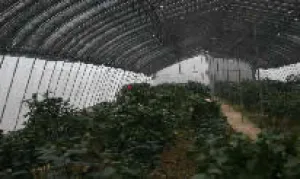 2.2 Camellia Garden in the Research Institute of Subtropical Forestry (RISF)
2.2 Camellia Garden in the Research Institute of Subtropical Forestry (RISF)
This camellia garden is located in Fuyang City, Zhejiang Province. The institute has been collecting camellias from Australia, Italy, Japan, New Zealand, USA since the 1980’s. The institute has set up greenhouses for the conservation of camellia varieties, a camellia germplasm area, breeding center and center of camellia media-culture and a large-scale propagation area. It has preserved well over 800 exotic and 100 domestic camellia varieties.
2.3 Camellia garden in the Kunming Institute of Botany of Chinese Academy of Science
In the last half century, the Institute has collected and planted more than a hundred C.reticulata varieties in its camellia garden which is the largest and oldest camellia garden in Yunnan. Most of the Yunnan Camellia trees in this garden are more than 50 years old. All year round, the camellia garden is open to the public and the best visiting season is February when people can enjoy Yunnan Camellias at their best.
2.4 Yellow Camellia Park in Nanning, Guangxi Zhuang Autonomous Region
The Yellow Camellia Park in Nanning was open to the public in December 30, 1995. It was founded by Madam Chen Muhua, the honorary president of China Flower Association. This is the most comprehensive pool of Yellow Camellias in China and even in the world. The total area is about 30 hectares and about 7,600 plants were planted. There are more than 30 yellow camellia species and more than 200 camellia varieties in this park
 2.5 Camellia Garden in the Chongqing Nanshan Botanical Garden
2.5 Camellia Garden in the Chongqing Nanshan Botanical Garden
The Nanshan area in Chongqing is the center of camellia cultivation, with more than 150 hectares and more than 1 million individual plants. There are 700 camellia varieties, and 2 million camellia plants collected in the Nanshan Botanical Garden, of which over 60 varieties are from Sichuan, 40 more from Yunnan, 40 more are from the Eastern area, 4 are yellow camellias. There is a unique variety called ‘Chongqing Red’ which is a late-flowering variety.
2.6 Camellia Garden in the Jingshan Park, Wenzhou City
Wenzhou is located in the southeast coast, and has a good natural environment suitable for growing camellias. It is known as ‘Camellia town’. There are 16 camellia species and 200 varieties of camellias originated from here. According to records, as early as the 7th century, the Japanese introduced camellias from Wenzhou City. Then they spread into Europe and America in the eighteenth century. There are more than 5,000 camellias and 200 pots of camellias collected and planted in Jinshan Park. More than 500 famous and rare exotic camellia varieties grow well in this park.
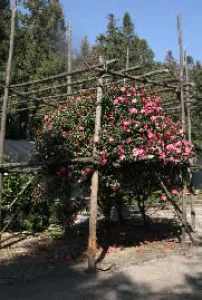 2.7 Camellia Garden of the National Laifeng Forest Park in Yunnan
2.7 Camellia Garden of the National Laifeng Forest Park in Yunnan
Laifeng Mountain National Forest Park is one of twelve famous sightseeing zones in Tengchong County in western Yunnan Province. The park is full of plants, and forests cover more than 90%, with the highest altitude of 1912 meters, and the lowest altitude of 1640 meters. There are more than 300 species of wild birds, and 50 species of mammals. There are more 110 C.reticulata varieties, and 2,500 camellia plants with varying colors in this westernmost camellia park.
References
Chang Hungta et Ren Shanxiang, 1998. Flora of China, Tomus 49(3). Beijing, China: Science Press.
Feng Guomei, Xia Lifang, Zhu Xianghong, 1981.Yunnan Camellias. Kunming, Yunnan: People’s Press.
Liang Shengye, 1993. Yellow Camellias. Beijing, China: Forestry Press.
Ming Tien-lu, 2000. Monograph of the Genus Camellia. Kunming, Yunnan, China; Kunming Yunnan Science and Technology Press.
Xia lifang, 2003. Camellias. Beijing, China: Architecture Industry Press.
You Muxian, 2010. Ten Years of Searching Ancient camellias in China. Hangzhou, Zhejiang, China: Zhejiang Science and Technology Press.
Web design by Tribal Systems
